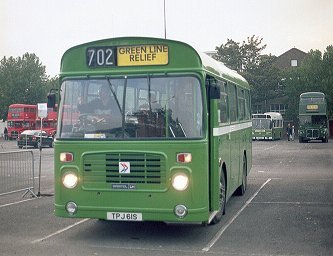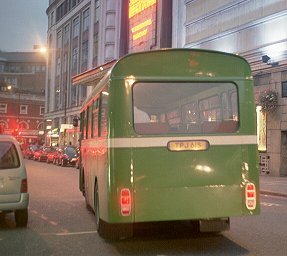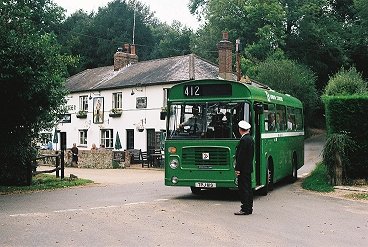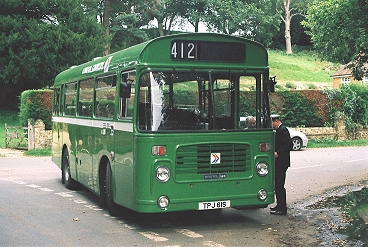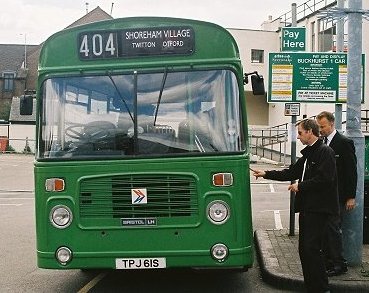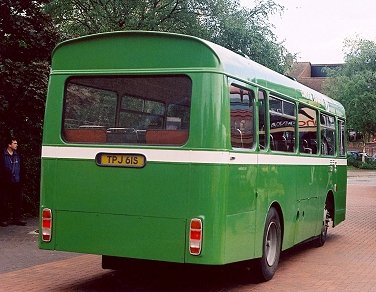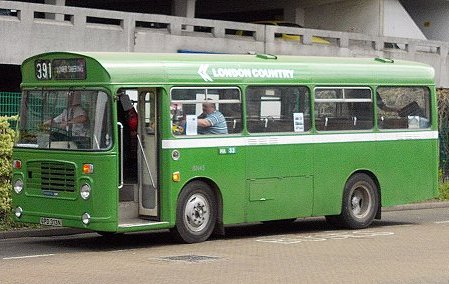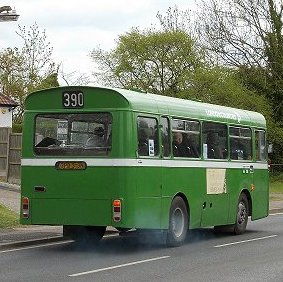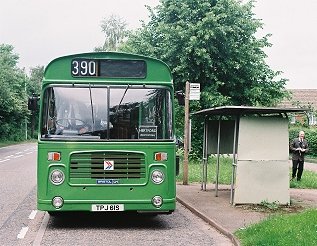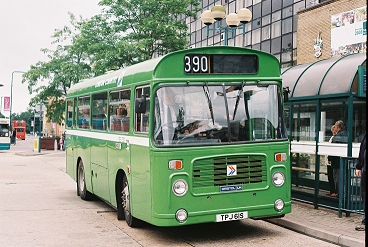
The LONDON AREA BRISTOL LHs
|
| Date | Gar. | No. | Route | Days |
|---|---|---|---|---|
| 10/73 | DG | 404 | Ide Hill - Sevenoaks - Otford - Twitton/Shoreham Village | 4/3/0 |
| 10/73 | DG | 413 | Sevenoaks - Chipstead | M-F |
| 10/73 | DG | 421 | Sevenoaks - Kemsing | |
| 10/73 | DG | 431 | Sevenoaks - Knockholt Pound - Halstead - Orpington - Chipstead | M-F |
| 10/73 | DG | 471 | Orpington - Cudham - Knockholt Pound - Orpington/Sevenoaks | M-F |
| 10/73 | DG | 483 | Sevenoaks - Westerham - Chelsham - West Croydon | M-F |
| 10/73 | SA | 355 | Borehamwood - Radlett - Harpenden | 8/7/1 |
| 10/73 | SA | 304 | Radlett - St.Albans - Whitwell/Hitchin | 3/2/0 |
| 10/73 | SA | 382 | St.Albans - Codicote | 1+RF/1/0 |
| 10/73 | SA | 313 | St.Albans - Enfield Town | Sun |
| 10/73 | SA | 356 | St.Albans - Napsbury/Shenley Hospital | Sun |
| 12/73 | MA | 348 | Chesham Moor - Lee Common - Chartridge | 1/1+RF/0 |
| 12/73 | MA | 359 | Quill Hall Estate - Amersham - Lee Common | 1/1/0 |
| 12/73 | MA | 398 | Quill Hall Estate - Penn - High Wycombe | 1 am-pk/0/0 |
| 1/74 | MA | 349 | Chesham Moor - Pond Park Estate/St.Leonards | 2/1/0 |
| 1/74 | MA | 394 | Tring - Chartridge | 2+RF/1/0 |
| 1/74 | MA | 332 | Quill Hall Estate - Beaconsfield - Penn | 1schools/0/0 |
BN 24-53
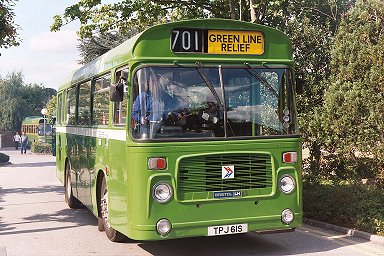
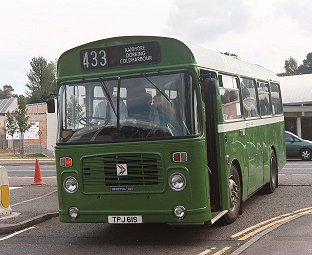
London's Transport Museum's BN61 worked on Dorking rural route 433 at the August 2003 Running Day.
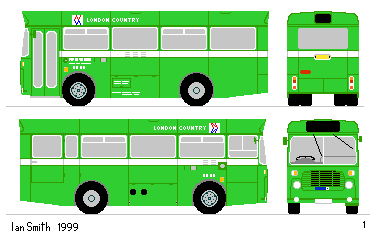
The narrower BN class followed on. Original plans had foreseen BLs going to Northfleet for the Gravesend network of small-bus routes, but some lanes near Betsham were too narrow for the wider buses, which had gone to Amersham instead.
The first thirty BN buses made their first appearance in August 1974,
and went to work on routes with narrow lanes, particularly in Kent,
Surrey and Hertfordshire.
They were allocated to Northfleet (NF), Chelsham (CM), Dunton Green (DG),
Dorking (DS), Leatherhead (LH) and Hertford (HG):
traditional GS country
- although by now it was RFs that they were replacing.
This first batch had a rear number-track blind like the BLs, and grey window seals.
Northfleet
Seven BNs (BN24-30) went to Northfleet for the Gravesend network of weekday small-bus routes (450, 489, 490), finding Sunday employment on otherwise RML-operated route 498. They also occasionally substituted for a coach on the 701 or 725. Even RMLs were substited sometimes, on routes such as the 487.| Date | Gar. | No. | Route | Days |
|---|---|---|---|---|
| 9/74 | NF | 450 | Dartford - Bean - Gravesend | M-Sat |
| 9/74 | NF | 489 | Ash - Longfield Stn - Gravesend | M-Sat |
| 9/74 | NF | 490 | New Ash Green - Longfield Stn - Gravesend | M-Sat |
| 9/74 | NF | 498 | Kings Farm Est(Sun) - Gravesend - Painters Ash (Sun)/Northfleet (M-Sat) | RML+1BL/RML/2BL |
London's Transport Museum's BN61 worked home from the Northfleet Running Day in October 2005 as a 702, as far as Victoria.
Guildford
Guildford joined the BN user's club in November with three BNs (31-33) for the 432, which used two on weekdays together with an MB on M-F, presumably to deal with school/peak loads. These three stayed on this duty for some considerable time (4, 6, 8 years respectively).| Date | Gar. | No. | Route | Days |
|---|---|---|---|---|
| 11/74 | GF | 432 | Guildford - Great Bookham | 2BN + MB/2/0 |
Dorking
Dorking received one of its BNs early. BN34 arrived in October, and went to work on the 425 and 439. It was joined in November by BN44 and BN46, the trio then going to work on the 412, where, like their GS and RF predecessors, a BN from Dorking was outstationed at Sutton (Holmbury St.Mary), where several of the staff lived, making possible inward early journeys and late outward ones (as well as being convenient for the staff). During the week - and on Sundays - the BNs also worked on the 425. The overprovision of BNs did not last, BN45 moving to Leatherhead in March 1975.| Date | Gar. | No. | Route | Days |
|---|---|---|---|---|
| 11/74 | DS | 412 | Dorking - Westcott - Holmbury St.Mary - Sutton | 2/2/0 |
| 11/74 | DS | 425 | Redhill - Dorking - Westcott - Guildford | M-Sun |
London's Transport Museum's BN61 on 412 at Sutton (Volunteer) on Dorking Running Day, September 2007.
Replacements for defective buses
London Country went through a bad patch of defective buses, both old and new, in no way assisted by the policies of British Leyland: bus spare parts were almost impossible to obtain, and order times could be over a year. So a number of new BNs were scattered around the network, to Dunton Green, Leatherhead, Chelsham, and Hertford to fill in some of the gaps. It became not rare to see BNs on Green Line duties.| Date | Gar. | No. | Route |
|---|---|---|---|
| 11/74 | LH | 408 | Chelsham - West Croydon - Epsom - Guildford |
| 11/74 | LH | 425 | Leatherhead - Box Hill - Tadworth |
| 11/74 | LH | 419 | Langley Vale - Epsom - Bretgrave |
| 11/74 | LH | 481 | Epsom - Wells Estate |
| 11/74 | LH | 470 | Warlingham - West Croydon - Epsom - Dorking |
| 11/74 | HG | 308 | Hertford - Cuffley |
| 11/74 | HG | 333 | Hertford - Bengeo |
| 11/74 | CM | 464,465,485 | Oxted triangle |
| 11/74 | CM | 453 | Chelsham - Caterham |
| 11/74 | DG | 404 | Ide Hill - Sevenoaks - Otford - Shoreham Village |
One of the routes that needed supplements in November 1974 was the 404, where it was BLs that needed spare parts. BN61 was not built at that stage, but visited the 404 on Sevenoaks Running Day, May 2008. The lack of a rear route indicator box on this later batch is apparent.
Chelsham
In December 1974 the position at Chelsham was regularised, with three BNs (37, 48, 52) officially allocated for working the Oxted triangle, with some journeys on the 453.| Date | Gar. | No. | Route |
|---|---|---|---|
| 12/74 | CM | 464 | Westerham - Oxted - Holland/Tandridge/Staffhurst Wood |
| 12/74 | CM | 465 | Edenbridge - Oxted - Holland/Tandridge/Staffhurst Wood |
| 12/74 | CM | 485 | Edenbridge - Westerham |
| 12/74 | CM | 453 | Chelsham - Caterham |
Hertford
Hertford had received a leavening of BNs in November 1974, but in February 1975 gained some more, officially to convert several of Hertford's rural routes, many of which had seen GSs not many years before. BN36,39,47, 49, 50, 51 and 53 were the allocation. Just seven BNs serviced a complex net of routes, in some cases alongside other types as loadings dictated:| Date | Gar. | No. | Route |
|---|---|---|---|
| 2/75 | HG | 308 | Hertford - Cuffley - Goffs Oak |
| 2/75 | HG | 386 | Hertford/Bishops Stortford/Hitchin |
| 2/75 | HG | 388 | Hertford - Welwyn Garden City |
| 2/75 | HG | 350 | Bishops Stortford - Hertford - Potters Bar - New Barnet |
| 2/75 | HG | 351 | Bishops Stortford - Ware - Hertford - Potters Bar |
| 2/75 | HG | 331 | Hertford - Standon - Buntingford (just 1) |
| 2/75 | HG | 337 | Hertford - Braughing - Buntingford (M-S) |
| 2/75 | HG | 395 | Hertford - Fanham Common (Sun) |
| 2/75 | HG | 327 | Hertford - Nazeing (one jny) |
| 2/75 | HG | 333 | Hertford - Molewood |
| 2/75 | HG | 384 | Hertford - Benington Green (early a.m.) |
| 2/75 | HG | 389 | Ware circular (evenings) |
| 2/75 | HG | 393 | Hertford - Broxbourne (evening) |
Leatherhead
Leatherhead had also received BNs as fillers in November 1974, and in March 1975 seven (BN35, 38, 40, 42, 43, 45 and 46) were moulded into a regular timetable allocation, again often including other types for capacity or scheduling reasons:| Date | Gar. | No. | Route |
|---|---|---|---|
| 3/75 | LH | 416 | Esher - Leatherhead - Box Hill |
| 3/75 | LH | 419 | Langley Vale - Epsom - Bretgrave |
| 3/75 | LH | 481 | Epsom - Wells Estate (M-S) |
| 3/75 | LH | 468 | Epsom - Chessington Zoo (M-F) |
| 3/75 | LH | 462 | Leatherhead - Fetcham (1 on Sat) |
| 3/75 | LH | 472 | Leatherhead - Netherne Hospital (W,Sun) |
Change
Through the mid seventies politics and policies changed. Councils served by London Country in many cases were reluctant to subsidise buses. Ratepayers in the affluent Home Counties were increasingly car-borne, with multiple car families, and reluctant to support those without their wealth. Routes were pruned. The bus spares situation worsened as British Leyland disintegrated as a supporting industry, seeming only to care about the Leyland National. The Merlins and Swifts were considered beyond redemption, and the RMLs were uneconomic with their conductors. RFs were getting very long in the tooth. London Country, strapped for cash, nevertheless had to re-equip, and settled on the short Leyland National bus and the Leyland Atlantean double-decker as fleet standards. Where physically possible, these larger buses were used (standard bus operating policy), avoiding peak-hour duplication. The little Bristols were squeezed off some routes, and were used to displace the remaining RFs where lack of size mattered.The outstation at Sutton came to an end. BLs found work on other routes, such as the 402 at Dunton Green, where the little BLs shared routes with hired Bristol MW coaches from Royal Blue.
In 1975 the Oxted triangle was dismantled, the 485 being converted to bigger buses and working through to Westerham from East Grinstead. The 465 disappeared, leaving the 464 working a star of routes reaching Chart, Limpsfield, Oxted, Holland, Staffhurst Wood, Tandridge with just two BNs from Chelsham. Fifteen months later the 465 was back, as a Community Bus serving various outlying places on different days of the week, such as Chalkpit Wood, Tandridge, Tatsfield & Biggin Hill, Chart & Crockham Hill.
Grays
There were signs that some people recognised the role that midibuses came to fulfill later: as community buses, or estate penetrators, going where larger buses could not go, and there were some innovations. At Grays a town service was introduced, a two-loop Town Service that went into the poorer estates, using BNs ousted from Hertford by SNBs. A spare BN was used to work the 374 (Grays - Linford. The three Grays BNs, between 399 runs, interworked onto most of the Grays area routes, long and short, in this industrial enclave on the north side of the Thames Estuary.Harlow
Harlow became a BN user in April 1977, with BN35,38 and 45 from Leatherhead. They too were used for estate penetration, on new route 809 (Harlow Town Service), as well as taking over on the 391 to Sawbridgeworth and Lower Sheering.BN45 took an active part at Harlow Running Day in May 2013, including a 390/391 trip to Lower Sheering and back, as well as working on the 809.
Ramblers Buses
Another innovation in 1977 were the Ramblers Buses. The first, in 1977 and subsequent years, on Summer Sundays and Bank Holidays, was a Surrey County Council supported service covering much of the area previously served by the 433 around Dorking, Leith Hill, Coldharbour and Ranmore. 1979 saw the introduction of the Lea Valley Leisure Bus, between Broxbourne Station, Waltham Cross and Hertford Garage, and a Ramblers Bus from Sevenoaks.BN 54-67
Fourteen more BNs arrived in the autumn of 1977. BN54-67 were grabbed by London Country when they became available, rather than being pre-ordered. It was not that London Country saw a continued niche for the raucous little monsters, but that they needed buses. Any buses. British Leyland was busy doing away with the British bus industry, and few buses were available. The new batch lacked some London Country features, the most obvious being the rear route indicator.. Inside the seats were covered in plastic rather than moquette. Rubber window surrounds were black rather than creamThe first one went to Dorking in September for a contract, then moved to Dunton Green with BN62 and BN64 to oust the hired MWs. BN 55,60,63,65 went to Hertford, putting small buses back onto some routes (350,351,384 and 308), freeing up SNB Nationals for other work. Leatherhead received five (BN56,57,58,66,67) to replace the three that had gone to Harlow and dispose of RFs and SMs. Grays, which was working its small group hard, received BN59 as an extra, as did Northfleet with BN61.
In later years BNs had regular commitments on Hertford's 390 at weekends. Here BN61 recreates a 390 service between Hertford and Stevenage in June 2008..
Rundown
Their working lives with London Country were short: in the late seventies buses of this size could not make money, even if fully loaded, and the era of widespread tendered services was still to come. First to go was BL9, withdrawn in August 1977. The other BLs, just seven years old, were withdrawn in 1980 as their Certificates of Fitness became due. Some became trainers. The Amersham and St Albans BL duties were replaced with BNs gleaned from the fleet by redundancies elsewhere, with Chelsham and Guildford losing their entire complements. BNs were displaced by Nationals or even Atlanteans, in pursuit of big bus policy. The BNs were whittled away during the early eighties, with Amersham, perhaps unsurprisingly, keeping them longest on the Chiltern ridge routes. So there were still a few extant when London Country was disassembled, all at Amersham in the new London Counbtry North-West. The last BNs surrendered to Nationals in December 1987.Most of the LH buses were welcomed into the bosoms of other operators, who made them pay by working them to death. A few survive.
Survivors
BN33 has been restored to London Country livery, with four-piece windscreen, in N.IrelandBN45 has been restored by Three Counties Bus & Commercial Vehicle Museum, and is active
BN50 has been restored to London Country livery, and is actively preserved in Billericay.
BN61 has been restored to London Country livery, and is with London's Transport Museum at Acton
![]()
 Ian's Bus Stop
Ian's Bus Stop
 BS, BL
BS, BL
 BL, BN
BL, BN
 histories
histories
 photos
photos
![]()
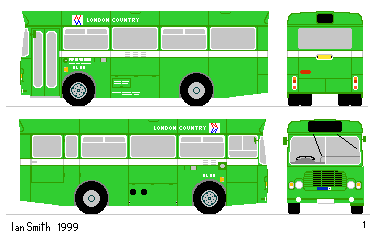 The twenty-three BLs started to arrive first, from October 1973.
They were painted in standard NBC green, with fleet names and NBC logos in white.
They had three track number indicators at the rear, and a single blind aperture at the front, for traditional blinds.
There was no side route indicator, as traditional in the Country Area.
The window seals were cream-coloured.
The twenty-three BLs started to arrive first, from October 1973.
They were painted in standard NBC green, with fleet names and NBC logos in white.
They had three track number indicators at the rear, and a single blind aperture at the front, for traditional blinds.
There was no side route indicator, as traditional in the Country Area.
The window seals were cream-coloured.
